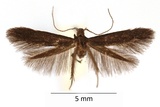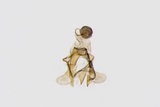Coleophora coracipennella (Hübner, 1796) Species
Last modified: Nov. 27, 2025, 8:10 p.m.
This is a very rare species that is easily confused with some other Coleophora species (see remark in 'Bionomics').
Details
- Classification
- Family: Coleophoridae > Genus: Coleophora > Species: Coleophora coracipennella
- Vernacular names
- Donkergrijze kokermot (NL), Blackthorn case-bearer (EN), Obstbaumsackmotte (DE)
- Synonyms
- Coleophora nigricella (Stephens, 1834)
- First mention in Belgium
- De Fré Ch. 1858. Catalogue des Microlépidoptères de la Belgique. — Annales de la Société entomologique belge 2: 45–162. On page 143 (as C.[oleophora] Coracipennella. H.). view page
- Status
-
Native
Distribution
Case
At first, the tubular and tri-valved leaf case is light brown but when it reaches its final length of 6–7 mm it has darkened considerably.
The mouth angle is circa 45°.
See also bladmineerders.be.
Bionomics
Initially, the larvae live at the underside of the leaves making small blotch mines which are excised to construct a case. After hibernation inside the case, the caterpillars resume feeding, construct a new case, and cause sizeable fleck mines. They reach maturity by the end of May and pupate in June within the case which is attached to the upper side of a leaf.
Dissection of the genitalia is required to identify this moth with certainty since neither the external morphology nor the larva or case allow to distinguish it from some other Coleophora species (Coleophora prunifoliae, Coleophora serratella and Coleophora spinella). The hostplant can give a hint into the right direction but, Coleophora larvae are rather active when searching for a suitable pupation spot, this can lead to erroneous conclusions.
For this reason, often the name Coleophora nigricella (Stephens, 1834) –is in fact a junior synonym of C. coracipennella– is used as a collective name for the four species mentioned.
Flight periods
The adults are on the wing from the end of June till the beginning of August.
Observed on
- Host plant (species):
- Prunus spinosa
- Host plant (genera):
- Crataegus, Malus, Cotoneaster, Sorbus and Prunus
The caterpillar is polyphagous on Rosaceae, but it is found mostly on Prunus spinosa and Malus spp. Also species of Cotoneaster, Crataegus, Prunus and Sorbus are accepted as hostplant.


